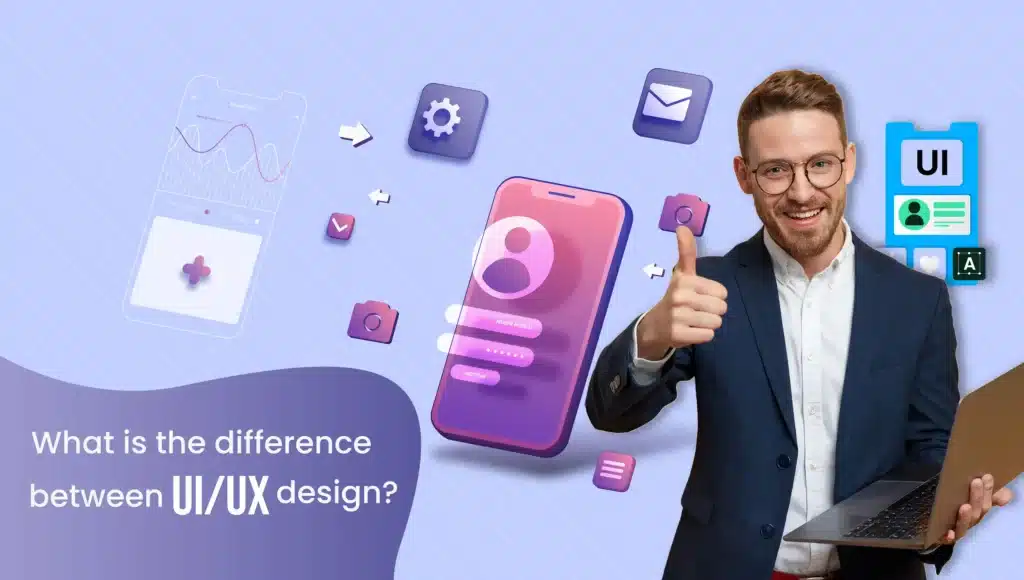Design plays a crucial role in how users interact with digital products and services. Whether it’s a mobile app, website, or software, the design of the interface can make or break the user experience. Two terms that often come up when discussing design are UI (User Interface) Design and UX (User Experience) Design. Many people use these terms interchangeably, but in reality, they represent two distinct aspects of product design. So, what is the difference between UI and UX design? In this article, we’ll dive deep into the roles of each and clarify how they work together to create seamless user experiences.
What is the Difference Between UI and UX Design?
UI and UX are two essential components that go hand in hand, but they focus on different elements of the design process. While both aim to improve how users interact with products, their goals and methodologies differ.
What is UX Design?
UX design focuses on the overall experience of the user. It encompasses all aspects of the user’s interaction with a product, from its functionality to how intuitive and enjoyable the experience is. The primary goal of a UX designer is to ensure that the product meets the needs of its users in the most efficient and pleasant way possible. This includes research, usability testing, prototyping, and making adjustments based on user feedback.
What is UI Design?
On the other hand, UI design is focused on the visual and interactive elements of a product’s interface. It deals with the look and feel of the product. A UI designer ensures that the product’s interface is aesthetically pleasing, easy to navigate, and visually aligned with the brand’s identity. UI design involves the layout of buttons, fonts, colors, icons, and images, creating an interface that enhances usability and user engagement.
Key Differences Between UI and UX Design
The difference between UI and UX design boils down to the following:
- Focus: UX design is about the entire journey a user takes with a product, from start to finish. UI design, on the other hand, focuses on the visual touchpoints that users interact with.
- Process: UX design involves research, wireframing, and user testing to improve the product’s usability. UI design revolves around the visual design process, including elements like colors, typography, and layout.
- Goal: UX design aims to create a product that provides a seamless, intuitive, and effective experience. UI design aims to ensure that the product’s interface is visually appealing and easy to use.
- Role: A UX designer is primarily concerned with the user’s journey, focusing on wireframes and user flows. A UI designer works on translating these wireframes into a visually compelling interface.
Now that we’ve understood the differences, let’s explore some specific terms related to UI and UX.
Interaction Design vs UX
Interaction design (IxD) and UX design are often confused, but they serve different purposes in the design process.
What is Interaction Design?
Interaction design is about designing the interactive elements of a product. It focuses on how users interact with the system and how the product responds. Interaction designers ensure that the interactions are clear, efficient, and satisfying. They create smooth transitions, buttons, and any other interactive elements that allow the user to navigate through the product.
What is User Experience Design?
User experience design, as previously discussed, involves the broader perspective of user interaction with a product. While interaction design deals with the micro-level details of user interaction, UX design looks at the macro-level experience. UX designers focus on the overall satisfaction of users and how the product fits into their needs and workflows.
Interaction Design vs User Experience Design
While both interaction design and user experience design are concerned with the user’s interaction with the product, the key difference lies in their focus. Interaction design is more about the specifics of interaction—buttons, controls, and feedback—while user interface user experience (UI/UX) design looks at the entire experience and how every aspect contributes to the user’s satisfaction. UX design focuses on the broader scope, ensuring that all elements, from the visual design to the functionality, work together to create a seamless and positive experience for the user.
UI and UX Web Design
In the context of web design, UI and UX play an essential role in ensuring a smooth and engaging website experience.
What is UI Web Design?
UI web design focuses on creating the visual layout and interactive elements of a website. It involves designing components like navigation bars, buttons, images, and typography to ensure a visually appealing interface. A UI designer must ensure that the website is visually consistent, easy to navigate, and optimized for different devices.
What is UX Web Design?
UX web design, on the other hand, focuses on the usability and user satisfaction of a website. UX designers study how users interact with websites and make decisions based on that research. They analyze how users navigate the website, identify pain points, and work on improving the overall experience.
In web design, both UI and UX need to be in sync. A beautiful website (UI) is useless if users find it difficult to navigate (UX). On the flip side, a well-functioning website that lacks aesthetic appeal may fail to attract users. Therefore, UI and UX web design must work together harmoniously to create a site that is both functional and visually engaging.
User Interface and User Experience
What is User Interface Design?
User interface design involves creating the layout, buttons, and visual elements that users interact with when using a website, app, or other digital products. The UI designer ensures that the interface is easy to use, visually appealing, and matches the brand’s identity.
What is User Experience Design?
User experience design goes beyond the interface and encompasses the entire user journey, from initial interaction to the final action. It’s about ensuring that the user can complete tasks efficiently while having a positive experience.
The key difference between user interface and user experience design is that UI design is about the visual presentation and interactive elements, while UX design is about the overall user journey and how well the product meets their needs.
UX Designer vs UI Designer
Who is a UX Designer?
A UX designer focuses on the functionality and usability of a product. They conduct research, create wireframes and prototypes, and conduct user testing to ensure the product meets the needs of its target audience. UX designers work closely with stakeholders to define user personas, identify pain points, and improve the overall user journey.
Who is a UI Designer?
A UI designer focuses on the visual aspects of a product’s interface. They ensure that the design is visually attractive, functional, and aligns with the brand’s style. UI designers work with color schemes, typography, icons, and other design elements to create an interface that is both beautiful and user-friendly.
The main distinction between a UX designer UI designer lies in the scope of their work. A UX designer is more concerned with the overall experience and usability of the product, ensuring that the user’s journey is intuitive, efficient, and enjoyable. They focus on understanding the needs of the users and improving their overall interaction with the product. In contrast, a UI designer is focused on the visual appeal and interactive elements of the product. They work on designing the interface, including the layout, colors, fonts, and buttons, making sure the product is not only functional but also aesthetically pleasing.
When discussing UI designer vs UX designer, the difference is clear. While UX designers handle the broader experience, ensuring usability and satisfaction, UI designers focus on the visual details and interactive elements. Both are essential in the design process, but they approach the product from different perspectives, working together to create a seamless user experience.
The Collaboration Between UI and UX Designers
While UI and UX designers have different roles, they must collaborate closely to create a successful product. A UX designer will typically create wireframes and prototypes, which a UI designer then transforms into visually appealing interfaces. Both must communicate effectively to ensure that the design meets both functional and aesthetic requirements.
Why Collaboration is Key
UI and UX designers bring complementary skills to the table. The UX designer ensures the product works well, while the UI designer ensures it looks good. By collaborating closely, they ensure that the product is not only user-friendly but also visually engaging.
Conclusion
So, what is the difference between UI and UX design? In summary, UI design focuses on the visual and interactive aspects of a product’s interface, while UX design focuses on the overall experience and usability. Both play vital roles in creating products that users love to interact with. Understanding the distinction between these two design disciplines is essential for creating digital experiences that are both functional and aesthetically pleasing.
By combining effective UX research and beautiful UI design, designers can create products that provide a seamless user experience, making users feel engaged, satisfied, and connected. As the tech world continues to evolve, the need for skilled UX designers and UI designers will remain at the forefront of product development.
In the end, whether it’s interaction design vs user experience design or understanding the roles of UX designer vs UI designer, both fields work together to ensure that digital products serve their users well.
FAQ
What is the major difference between UI and UX?
The major difference is that UI (User Interface) design focuses on the visual and interactive elements of a product, while UX (User Experience) design focuses on the overall experience and usability, ensuring the product meets user needs efficiently and effectively.
Is it better to be a UX or UI designer?
It depends on your strengths and interests. If you enjoy problem-solving and research to improve user interactions, UX design may be more suitable. If you’re passionate about creating visually appealing interfaces, then UI design could be the better fit.
Who is paid more, UI or UX?
In general, UX designers tend to be paid more due to the extensive research, testing, and strategic thinking involved in their roles. However, salaries can vary depending on experience, location, and the specific company.
Is UX a lot of coding?
While UX design doesn’t typically involve heavy coding, some knowledge of basic front-end technologies like HTML and CSS can be helpful. However, the main focus is on research, user testing, and designing intuitive experiences.
Is UX front end or back end?
UX design is primarily front-end as it deals with how users interact with the product. However, it involves collaboration with both front-end and back-end teams to ensure a seamless experience across the entire product.
Is UI easier than UX?
UI design may seem easier as it focuses on the visual elements and layout, but it still requires a deep understanding of design principles. UX design, on the other hand, involves extensive user research and testing, which can be more complex.
Does UI/UX require coding?
UI/UX design does not require extensive coding. While knowing some front-end technologies (HTML, CSS, JavaScript) can be beneficial, the primary focus is on design and user experience rather than development.
What does a UX designer do?
A UX designer is responsible for researching user needs, creating wireframes and prototypes, and conducting user testing to ensure the product is usable, intuitive, and provides a positive experience. They focus on optimizing the overall user journey.


